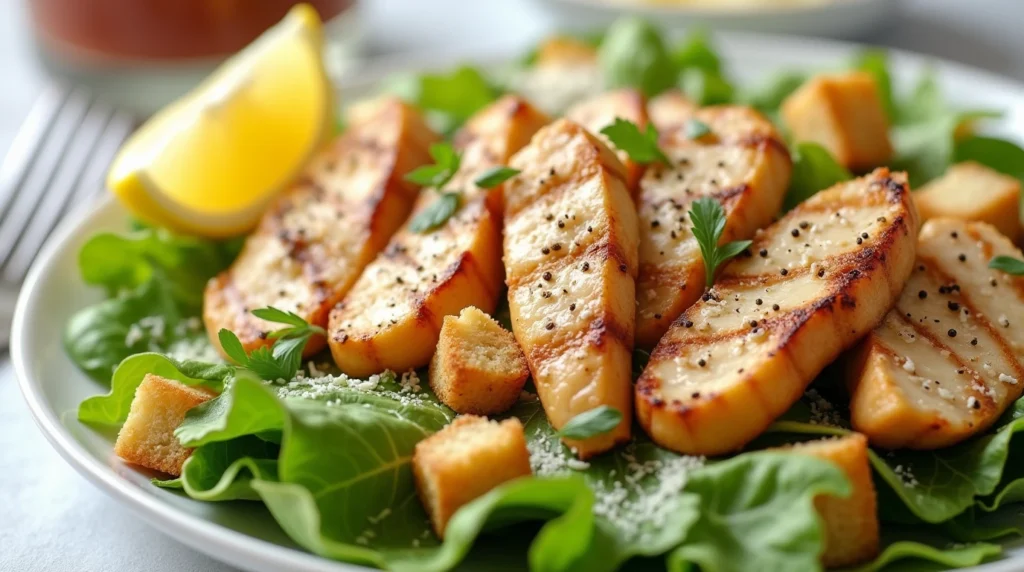Chicken Caesar: How To Make 3 Restaurant-Quality Versions
Table of Contents
Are you tired of lackluster salads that leave you reaching for snacks an hour later? A properly made Chicken Caesar has the power to transform your lunch or dinner into a satisfying, restaurant-worthy experience. This isn’t just any salad – it’s a perfect balance of crisp romaine, savory chicken, crunchy croutons, and that unmistakable Caesar dressing that keeps you coming back for more.
As a professional chef who’s spent 15 years perfecting Caesar salads in high-end restaurants, I’ve developed foolproof methods to elevate this classic dish. Whether you’re looking for a traditional Chicken Caesar experience, a lighter version, or something with a modern twist, I’ve got you covered.
In this guide, you’ll discover how to select the perfect chicken cuts, master homemade dressing, and assemble a Chicken Caesar that rivals your favorite restaurant’s version. I’ll also share time-saving tips, equipment recommendations, and answers to common questions that home cooks face when preparing this beloved dish.
Why This Chicken Caesar Recipe Works
- Uses simple, high-quality ingredients for maximum flavor impact
- Includes three distinct preparation methods to suit different tastes and occasions
- Perfect balance of protein, greens, and crunch for a satisfying meal
- Versatile enough for a quick weeknight dinner or elegant dinner party
- Prep components ahead for a 10-minute assembly when you’re ready to eat

Choosing the Right Chicken
Best Cuts for Chicken Caesar
The chicken is the star protein in this classic salad, and your choice of cut makes a significant difference. Boneless, skinless chicken breasts are the traditional choice for Chicken Caesar – they’re lean, cook quickly, and slice beautifully over the romaine. However, chicken thighs offer more flavor and moisture, making them an excellent alternative if you prefer juicier meat.
Buying Tips
Look for chicken that’s firm to the touch with a pinkish color (avoid pale or gray chicken). For the best flavor and texture, opt for air-chilled chicken rather than water-chilled, as it produces a better texture when cooked. If your budget allows, free-range or organic chicken typically delivers superior flavor for your Chicken Caesar.
Substitutions
If you’re short on time, a quality rotisserie chicken makes an excellent substitute – simply shred or slice the breast meat. For a vegetarian version, try marinated and grilled portobello mushrooms or crispy tempeh as your protein base while keeping the classic Caesar dressing elements.
Ingredients & Prep
Chicken Prep Essentials
For the perfect Chicken Caesar, preparation is key. Pound chicken breasts to an even thickness (about ½ inch) to ensure even cooking. For maximum flavor, consider brining your chicken for 30 minutes in a solution of 4 cups water, ¼ cup salt, and 2 tablespoons sugar before cooking – this helps keep the meat juicy and well-seasoned throughout.
Marinades/Seasonings
Classic Chicken Caesar uses a simple marinade of olive oil, lemon juice, garlic, and herbs. For best results, marinate chicken for at least 30 minutes, but no more than 4 hours, as the acid in the lemon juice can start to “cook” the protein if left too long. A basic dry rub of salt, pepper, garlic powder, and dried herbs also works beautifully for a quick preparation.
Pantry Staples
To create an authentic Chicken Caesar experience, keep these essentials on hand:
- Quality olive oil (both for cooking and dressing)
- Fresh lemons for juice and zest
- Garlic cloves
- Dijon mustard
- Worcestershire sauce
- Parmesan cheese (buy a block and grate it fresh)
- Anchovy paste or whole anchovies (the secret to authentic Caesar flavor)
Step-by-Step Cooking Instructions
Pre-Cooking Prep
- Remove chicken from refrigerator 20 minutes before cooking to take the chill off
- Pat chicken completely dry with paper towels (this helps achieve better browning)
- Season chicken generously with salt and pepper on both sides
- Prepare your work station with a meat thermometer and tongs
Cooking Method 1: Classic Grilled Chicken Caesar
- Preheat grill to medium-high heat (around 400°F)
- Brush chicken with olive oil to prevent sticking
- Grill chicken for 5-7 minutes per side, until internal temperature reaches 165°F
- Remove from grill and rest for 5 minutes before slicing against the grain
Cooking Method 2: Crispy Panko Chicken Caesar
- Preheat oven to 425°F
- Dredge chicken in flour, then beaten egg, then panko breadcrumbs mixed with grated Parmesan
- Place on a wire rack set over a baking sheet
- Bake for 15-18 minutes until golden and internal temperature reaches 165°F
- Rest for 5 minutes before slicing
Cooking Method 3: Sous Vide Chicken Caesar
- Set sous vide circulator to 145°F
- Season chicken and place in vacuum-sealed bag with a sprig of rosemary and slice of lemon
- Cook for 1.5 hours
- Finish with a quick sear in a hot skillet (2 minutes per side) for color and texture
- Rest briefly before slicing
Doneness Check
The FDA recommends cooking chicken to an internal temperature of 165°F for safety. However, if using the sous vide method, 145°F is safe when held at that temperature for the recommended time, resulting in exceptionally juicy chicken for your Chicken Caesar.
Resting
Always let your chicken rest for at least 5 minutes before slicing. This allows the juices to redistribute throughout the meat, ensuring your Chicken Caesar features tender, moist protein instead of dry, stringy chicken.
Pro Tips for Perfect Chicken Caesar
Avoiding Tough/Dry Chicken
- Don’t overcook! Use a meat thermometer rather than relying on time alone
- Consider brining chicken before cooking for insurance against dryness
- Slice chicken against the grain for more tender bites in your Chicken Caesar
- If using chicken breast, remove it from heat when it reaches 160°F – it will continue cooking to 165°F while resting
Tool Recommendations
- Instant-read digital thermometer for perfect doneness every time
- Tongs for easy flipping and handling of chicken
- Cast-iron grill pan for indoor “grilled” chicken with beautiful marks
- Microplane grater for fresh Parmesan (far superior to pre-grated)
- Quality chef’s knife for clean, even chicken slices
Storage & Reheating
For meal prep, store cooked chicken separately from salad components. Chicken will remain good for 3-4 days refrigerated. To reheat without drying out, place chicken in a 275°F oven with a small pan of water until warmed through (about 15 minutes), or microwave at 50% power with a damp paper towel covering the chicken.
Flavor Variations
Spicy Blackened Chicken Caesar
Transform your Chicken Caesar with a coating of blackening spice (paprika, cayenne, garlic powder, oregano, thyme) before cooking. The spice crust adds a wonderful depth and moderate heat that pairs beautifully with the cooling Caesar dressing.
Keto/Paleo Chicken Caesar
Create a diet-friendly Chicken Caesar by replacing croutons with toasted pumpkin seeds or crushed pork rinds. Make a keto-friendly dressing using mayonnaise, Dijon mustard, garlic, anchovy paste, lemon juice, and grated Parmesan. Increase olive oil for additional healthy fats.
Global Flavors: Mediterranean Chicken Caesar
Give your Chicken Caesar a Mediterranean twist by marinating chicken in Greek yogurt, lemon juice, garlic, and oregano before grilling. Add kalamata olives, cucumber, cherry tomatoes, and feta cheese to the finished salad, and top with a tzatziki-inspired Caesar dressing.
Serving Suggestions
A well-executed Chicken Caesar can stand alone as a complete meal, but for a more substantial offering, consider these accompaniments:
- Garlic bread or warm crusty baguette
- Cup of tomato bisque or roasted red pepper soup
- Simple side of roasted fingerling potatoes
- Fresh fruit plate for a sweet contrast
For beverages, a crisp Sauvignon Blanc or Pinot Grigio complements the creamy dressing and savory chicken perfectly. For beer lovers, a light pilsner or wheat beer makes an excellent pairing with Chicken Caesar.
FAQs
Can I make it ahead of time?
Prepare components separately up to 24 hours in advance. Store washed and dried romaine, cooked chicken, and dressing separately in the refrigerator. Assemble just before serving to maintain optimal texture and freshness.
Is it safe during pregnancy?
Traditional Caesar dressing contains raw eggs, which may pose a risk during pregnancy. Use pasteurized eggs or store-bought Caesar dressing labeled as containing pasteurized eggs. Ensure chicken is cooked to 165°F internal temperature.
How do I fix bland Caesar dressing?
If your Caesar dressing lacks punch, try adding more anchovy paste (1/4 teaspoon at a time), an extra garlic clove, more lemon juice, or a splash of Worcestershire sauce. Always taste and adjust seasonings before dressing your salad.
Conclusion
With these three restaurant-quality Chicken Caesar recipes in your repertoire, you’ll never settle for a mediocre salad again. Whether you choose the classic grilled version, the crispy panko-crusted variation, or the perfectly juicy sous vide method, you’re now equipped to create a Chicken Caesar that’s worthy of being the main attraction at any meal.
Don’t be surprised when family and friends request your Chicken Caesar for gatherings – these techniques transform a simple salad into a memorable dining experience. Ready to elevate your salad game? Start with whichever version appeals most to your taste and equipment, and you’ll soon be making Chicken Caesar that rivals any restaurant’s offering.
For more protein-packed salad ideas, check out our related recipe: Steak Salad with Chimichurri Dressing!
Did you like this recipe?
There are no reviews yet. Be the first one to write one.

